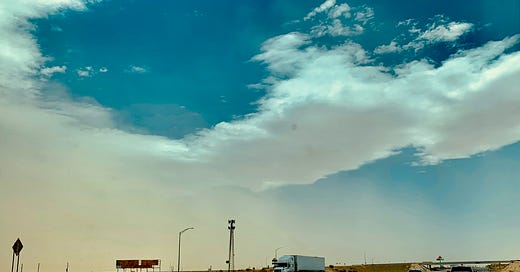And to dust we shall return
She started to cough that winter, a baby’s ragged hiccup, and it never stopped. Though Hazel Shaw had sealed the windows and doors and draped an extra layer of wet sheets over the openings, the dust still found Ruth Nell in her crib.
Near the end of May, we left southern Arizona and entered New Mexico driving east on the long, mostly straight arrow of I-10 into the desert flats that make up much of the ride from the state line to the destination cities of Las Cruces and Roswell.
We’d been this way before and the desolate landscape was not one of our favorite routes from the Southwest back to the Midwest. But we took this road because the National Weather Service — still adequately funded at the time, as far as we knew —- had issued a high wind advisory for northern Arizona, a scary weather event that we for sure did not want to experience on twisty mountain roads. So we stayed well to the south and headed into the barrens, as my husband and I thought of this perpetually drought-stricken stretch. On an ordinary day, you’d often see small dust devils of fine white particles pirouetting over the scrubby terrain. In the past, we had found them entertaining. Busy little whirlwinds, mere wisps of energy, swirling but going nowhere. This was no ordinary day, however; a full-fledged dust storm was right in our path.
As we crossed the state line, the wind started blowing in earnest. Flashing, yellow highway blinkers warned of blinding dust; electronic signs urged drivers to pull onto the shoulder; turn off engines and headlights; feet off the brakes. The 18-wheelers exited the road and crammed the truck stops. Dust storms, also called haboobs, are defined by the American Meteorology Society as intense sandstorms that can rise as high as 5,000 feet bringing with them a gigantic wall of dust.
It was oddly reminiscent of a Midwestern snowstorm with looming clouds heaving toward the highway, clouds that you’d swear were harbingers of snow. Instead, fine sand — some of it white, some siena — pinged our car, drifted in piles over the the road, gave us coughing fits. Heavy gusts whipped around corners, unexpected blows out of nowhere.
It continued like this, on and off, for another four or five hours — through parched Lordsburg, through chile-maker Hatch (where, hoping for a respite, we turned onto northbound I-25), through historic pueblos.
By the time we reached the outskirts of Albuquerque, we joked that we’d now seen it all when it comes to storms: rain, snow, sleet, hail and now dust. And we relaxed as we meandered east and north under sunny, spring skies that caressed the newly planted fields of Oklahoma, Missouri, Iowa. But then we got to Illinois.
Th(e) year, 1935, had been one duster after the other and April showed no sign of letup, no rain in the forecast, four years into the drought. At the end of March black blizzards had fallen for twelve straight days. During one of those storms, the wind was clocked at forty miles an hour or better — for a hundred hours.
We were just about three hours from home when I saw it. A wall of dust. It was hard to wrap our minds around it; yes, there is a record mega-drought in the Southwest but we were now in northern Illinois. A dust storm … here? The fertile Illinois soil rose like a black mist from fields, borne aloft on 60 mile-per-hour gusts. We later heard that the last time the region outside Chicago had seen a dust storm was in 1934 — nearly 100 years ago during the Dust Bowl of the mid to late 1930s.
The storm went on all night, banging our house and rattling the windows. By morning our rental car, now parked in the driveway, looked like it had been used for dirt track racing, its surface mottled by grit and tattered leaves and sticks. But we were safe.
Not so most of the people affected by the Dust Bowl, a multi-year environmental disaster that assaulted the Great Plains, sickened people with dust pneumonia, and forced hundreds of thousands of them from their homes. But first they had to bury their dead.
By the time, Charles made it to St. Mary’s Hospital, he was covered in dirt, his face was black. He went to the dust ward. Hazel was crying. Ruth Nell had died an hour earlier.
Notes:
Excerpts are from Timothy Eagan’s gripping work “The Worst Hard Time: The Untold Story of Those Who Survived the Great American Dust Bowl.” The National Book Award winning book will take you into a past you will never forget. The story of Charles and Hazel Shaw and their baby Ruth Nell can be found in the chapter entitled “Duster’s Eve."
More on haboobs. https://glossary.ametsoc.org/wiki/Haboob
Chicago dust storm. https://www.cbsnews.com/chicago/news/storms-bringing-large-hail-isolated-tornado-risk-on-friday-in-chicago/




